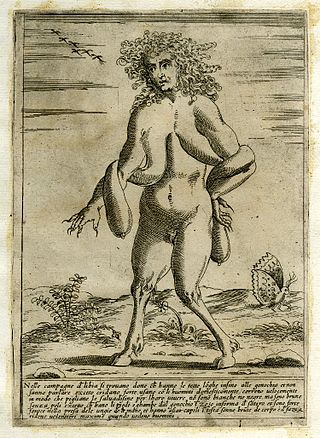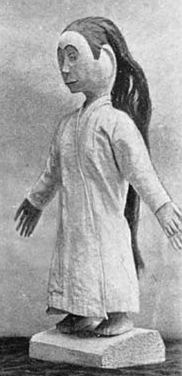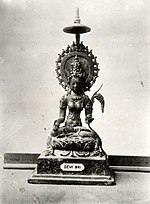
The Kuntilanak, also called Pontianak, or Yakshi in Hinduism/ Hindu mythology is a mythological creature in Indonesia, Malaysia and Singapore. It is similar to Langsuir in other Southeast Asia regions. The Pontianak usually takes the form of a pregnant woman who is unable to give birth to a child. Alternatively, it is often described as a vampiric, vengeful female spirit. Another form of the Pontianak refers to the ghost or white lady of Southeast Asian folklore.
Zashiki-warashi, sometimes also called zashiki bokko, are spirit-like beings told about mostly in the Iwate Prefecture. They are said to be yokai that live in parlors or storage rooms, and that perform pranks, and that people who see one would be visited with good fortune. There are also legends of how they would bring fortune to families. They are also known from Kunio Yanagita's Tōno Monogatari, Ishigami Mondō, and stories about them appear in the 17th and 18th chapters of the Tōno Monogatari and the 87th chapter titled "Zashiki-warashi" of the Tōno Monogatari Shūi. In the 17th chapter, it is written "families with whom this spirit dwells become prosperous". In recent years, television programs and magazines have reported about various Iwate Prefecture ryokan where it is said to be possible to see a zashiki-warashi.

Hantu is the Malay and Indonesian word for spirit or ghost. In modern usage it generally means spirits of the dead but has also come to refer to any legendary invisible being, such as demons. In its traditional context the term also referred to animistic nature spirits or ancestral souls. The word is derived from Proto-Malayo-Polynesian *qanitu and Proto-Austronesian *qaNiCu. Cognates in other Austronesian languages include the Micronesian aniti, Lio language nitu, Yami anito, Taivoan alid, Seediq and Atayal utux, Bunun hanitu or hanidu, Polynesian aitu or atua, and Tsou hicu among the Formosan languages. In terms of concept and place in traditional folklore, it is most similar to the Filipino anito.
The penanggalan or penanggal is a nocturnal vampiric entity from Malay ghost myths. It takes the form of a floating disembodied woman's head, with its organs and entrails trailing from its neck. From afar, the penanggalan is said to twinkle like a ball of flame, similar to the will-o'-the-wisp phenomenon.

There are many Malay ghost myths, remnants of old animist beliefs that have been shaped by Hindu-Buddhist cosmology and later Muslim influences, in the modern states of Brunei, Indonesia, Malaysia, and Singapore and among the Malay diaspora in neighbouring Southeast Asian countries. The general word for ghost is hantu, of which there exist a wide variety. Some ghost concepts such as the female vampires pontianak and penanggal are shared throughout the region. While traditional belief does not consider all ghosts as necessarily evil, Malaysian popular culture tends to categorise them all as types of evil djinn.
A jenglot is a small creature of Indonesian culture and mythology. It has the appearance of a deformed humanoid doll and whose size is up to 12 centimetres (4.7 in) in length. They have long hair which grows sparse and stiff through the legs, and long nails. The doll itself does nothing, but when imbued with black magic, is said to provide protection to its master, takes revenge on an enemy or works as a good luck charm. It can fetch thousands of ringgit or millions of rupiah when sold.
Pelesit is a type of familiar spirit in Malay folklore. It is generally a cricket, or occasionally a grasshopper. The term literally means "buzzer" from the root word lesit meaning to buzz or whizz, as an insect does. They are also called Palasik.
The polong is a type of familiar spirit in Malay folklore. It has the appearance of a miniature woman, the size of the first joint of the finger.
Hantu Air, Puaka Air or Mambang Air is the Malay translation for Spirit of the Water or Water Ghost, which according to animist traditions in Maritime Southeast Asia, is the unseen inhabitant of watery places such as rivers, lakes, seas, swamps and even ditches. Communication between humans and Hantu Air occur in situations based on the well-being of an environment and can be positive or negative. Water spirits are called on and communicated with through ceremonies, rituals, incantations, and in extreme cases exorcisms. Hantu Air is associated with bad things happening to people including missing persons, drowning, flooding and many other incidents.
The Hantu Raya is a type of familiar spirit in Malay folklore that acts as a double for black magic practitioners. Roughly meaning "great ghost", it is supposed to bestow great power onto its master. Its true form according to folktale is humanoid form with black hairy body except the facial area, rough grey skin, long sharp teeth and with red eyes.

Pocong is a ghost that looked like person who is wrapped in a funeral cloth. In Islamic funeral, a shroud called a "kain kafan" used to wrap the body of the dead person. The dead body is covered in white fabric tied over the head, under the feet, and on the neck, and the shroud is firmly tied at multiple junctures to maintain its position during the journey to the grave site. Upon placement into the grave, it is believed that the knots must be undone or the corpse will animate and be known as a Pocong. Pocong is also known in Malaysia as Hantu Bungkus.

Wewe Gombel is a female supernatural being or vengeful ghost in Javanese mythology. It is said that she kidnaps children.

Malay folklore refers to a series of knowledge, traditions and taboos that have been passed down through many generations in oral, written and symbolic forms among the indigenous populations of Maritime Southeast Asia (Nusantara). They include among others, themes and subject matter related to the indigenous knowledge of the ethnic Malays and related ethnic groups within the region.
Hantu Tinggi is a being similar to 'Hantu Raya' or 'genderuwo' but so tall its body from the waist up is hidden by clouds. It only exists in the Western and Eastern regions of Malaysia. In Thailand, Hantu Tinggi likely resembles a closer myth called Preta.

The langsuyar, also lang suir or langsuir, is a female revenant in Malay and other mythologies in the Malay archipelago. The word is derived from the Malay word for eagle.
In the culture of the Bunun of Taiwan, a hanitu or qanitu is a spirit. The concept does not exactly equate with similar myths from other cultures.

Roh, or known as Soul, is a 2019 Malaysian Malay-language independent folk horror film directed by Emir Ezwan in his directorial debut. Set in the past, a family living in a forest is visited by a strange little girl, who comes with a frightening prediction.

The House Spirit Tatami-chan a Japanese original net animation series produced Zero-G. The series aired online in Japan between April 10, 2020 to June 26, 2020.






